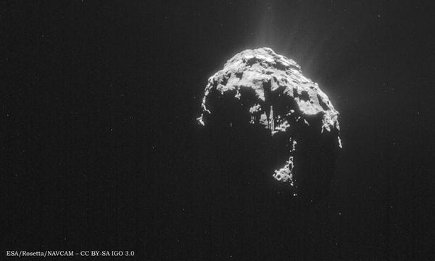Rosetta scores double

Two comets collided at low speed in the early Solar System to give rise to the distinctive ‘rubber duck’ shape of Comet 67P/Churyumov–Gerasimenko, say Rosetta scientists. The origin of the comet’s double-lobed form has been a key question since Rosetta first revealed its surprising shape in July 2014. Two leading ideas emerged: did two comets merge or did localised erosion of a single object form the ‘neck’?
A low-speed collision
Now, ESA announces spectacular news form space. Its scientists have found an unambiguous answer to the conundrum. By using high-resolution images taken between 6 August 2014 and 17 March 2015 to study the layers of material seen all over the nucleus, they have shown that the shape arose from a low-speed collision between two fully fledged, separately formed comets.
“It is clear from the images that both lobes have an outer envelope of material organised in distinct layers, and we think these extend for several hundred metres below the surface,” says Matteo Massironi, lead author from the University of Padova, Italy, and an associate scientist of the OSIRIS team. “You can imagine the layering a bit like an onion, except in this case we are considering two separate onions of differing size that have grown independently before fusing together.”
A depth of 650 meter
The results of the study are reported in the journal Nature and were presented today at the European Planetary Science Congress in Nantes, France.
To reach their conclusion, Matteo and his colleagues first used images to identify over 100 terraces seen on the surface of the comet, and parallel layers of material clearly seen in exposed cliff walls and pits. A 3D shape model was then used to determine the directions in which they were sloping and to visualise how they extend into the subsurface.
It soon became clear that the features were coherently oriented all around the comet’s lobes and in some places extended to a depth of about 650 m. “This was the first clue that the two lobes are independent, reinforced by the observation that the layers are inclined in opposite directions close to the comet’s neck,” says Matteo.
“To be sure, we also looked at the relationship between the local gravity and the orientations of the individual features all around the reconstructed comet surface.” Broadly speaking, layers of material should form at right angles to the gravity of an object. The team used models to compute the strength and direction of the gravity at the location of each layer.
In one case, they modelled the comet as a single body with a centre of mass close to the neck. In the other, they worked with two separate comets, each with its own centre of mass. The team found that orientation of a given layer and the direction of the local gravity are closer to perpendicular in the model with two separate objects, rather than in the one with a single combined nucleus.
Meest Gelezen
Vrouwen houden universiteit draaiende, maar krijgen daarvoor geen waardering
Wederom intimidatie van journalisten door universiteit, nu in Delft
‘Burgerschapsonderwijs moet ook verplicht worden in hbo en wo’
Raad van State: laat taaltoets nog niet gelden voor hbo-opleidingen
Hbo-docent wil wel rolmodel zijn, maar niet eigen moreel kompas opdringen

